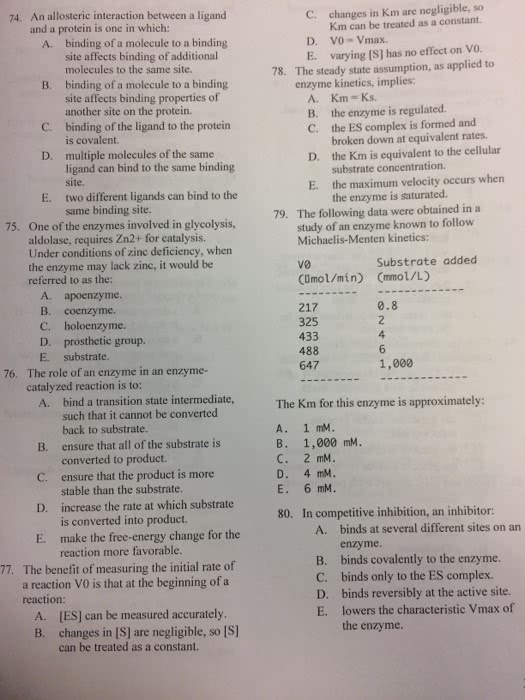BIOC2000 Lecture Notes - Lecture 8: Dna Polymerase Iii Holoenzyme, Okazaki Fragments, Dna Replication

Lecture 8: DNA Replication
Enzyme language
Vmax: The maximum rate/’velocity’ at which an enzyme can operate;
maximum amount of substrate > product conversions during a given time
Vmax when:
- temperature is optimal
- pH is optimal
- surplus of substrate (saturating [substrate])
- product may need to be removed; if there is an equilibrium, in a
reversible reaction the product can bind back to the enzyme
- no inhibitors of enzyme in system
T affects the fold of protein
pH affects fold of protein, could also affect protonation/deprotonation of
side chains at the active site – need to ensure fold is optimal and active site
has right charge on it
The cell has a problem – some enzyme kinetics
Cells have a problem of trying to ensure leading and lagging strand go at
the same rate - otherwise one strand will be copied a lot more than the
other – if this continues, a lot of SBB will be required to keep DNA strands
separate, eventually running out
On rate: the rate at which substrate and enzyme associate
3’ end is the substrate for the enzyme
The Pol on the lagging strand has a problem because it has to find the new
strand every time it falls off the other strand
Pol also has a problem with coming off – Off rate: the rate at which product
and enzyme dissociate
The lagging strand is running fast but probably at the same rate as the one
on the leading strand
Solution: Okazaki fragments allow cell to keep up with lagging strand
because there is no wait for entire lagging strand to be unraveled
There is a part of the polymerase that marks where new Okazaki fragments
needs to start (next starting point), so the body of the Pol can find it easily
Body of Pol has higher affinity for the marker than it does for the RNA
primer.
find more resources at oneclass.com
find more resources at oneclass.com

When DNA Pol jumps off one of these fragments looking for the next
marker, the leading strand can be held back – inhibits its function
So DNA Pol on Okazaki fragments operates at Vmax but one on leading
strand doesn’t.
Ignore all other green dots
DNA polymerases are not simple “blobs”, with one on each
strand of the replicating DNA
DNA polymerase III holoenzyme is the primary enzyme complex involved
in prokaryotic DNA replication.
The primary difference between transcription and DNA replication is that
only a single strand of mRNA is produced during transcription. During
DNA replication both strands need to be copied and DNA polymerase
needs to work on both strands at the same time.
Replication is the process of making two daughter DNA strands from a
single DNA strand. Transcription is the process of synthesizing RNA from
DNA strand/template
Bacteria are adapted to extreme conditions so their proteins do not easily
denature and are easy to work with, unlike human protein.
^ This slide and next is not examinable.
The lagging-strand polymerase is tethered to increase the on-rate and
allow it to keep up with the leading-strand polymerase
DNA replication and transcription are both processes that
involve making nucleic acids.
How does DNA Pol add bases?
When bases are added – it is creating more order, theoretically it shouldn’t
be able to happen according to free energy changes
Only final structure is correct – be able to draw in exam! (without the
bases)
dNMP(n) – nucleotides in a polymer (DNA)
dNTP - triphosphate
dNMP(n+1) – DNA, 1 longer
find more resources at oneclass.com
find more resources at oneclass.com

Do you need to memorize structures? no
Do you need to be able to recognize? no
- Have an understanding of an enzymatic mechanism behind how bases are
added and why they are
Bases themselves have nothing to do with the enzymatic mechanism for the
addition of bases to the DNA
The part with N in it is the base ‘nitrogenous base’
DNA Polymerase
• DNA replication is an intricate process that involves the interaction
of over twenty different proteins.
DNA (n) + dNTP -> DNA (n+1) + PPi
• So far in the cell, DNA is being replicated and so far there is n
number of nucleotides in DNA polynucleotide chain
• If one more n (nucleotide) is to be added, dNTP needs to be added
on, forming a phosphodiester bond, extending the DNA chain by
one (n+1) – in the process releasing PPi.
• DNA polymerase catalyses the formation of the phosphodiester
bond by adding deoxynucleotide triphosphates (dNTPs) onto the
growing polynucleotide chain. As each deoxribinucleotide is added
onto growing chain in a stepwise fashion, a pyrophosphate molecule
(PPi) is released.
• DNA polymerase:
(A) Require the four types of dNTP molecules
find more resources at oneclass.com
find more resources at oneclass.com
Document Summary
Vmax: the maximum rate/"velocity" at which an enzyme can operate; maximum amount of substrate > product conversions during a given time. Product may need to be removed; if there is an equilibrium, in a reversible reaction the product can bind back to the enzyme. T affects the fold of protein ph affects fold of protein, could also affect protonation/deprotonation of side chains at the active site need to ensure fold is optimal and active site has right charge on it. The cell has a problem some enzyme kinetics. On rate: the rate at which substrate and enzyme associate. 3" end is the substrate for the enzyme. The pol on the lagging strand has a problem because it has to find the new strand every time it falls off the other strand. Pol also has a problem with coming off off rate: the rate at which product and enzyme dissociate.



